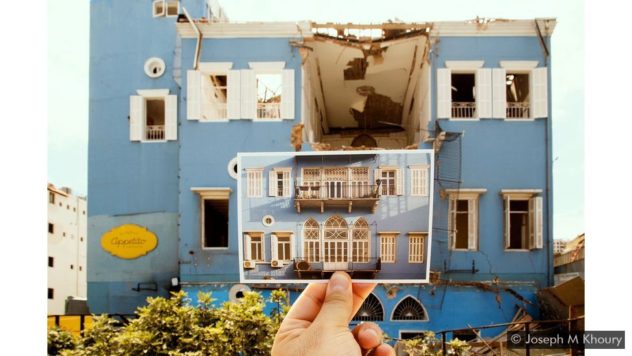© Joseph Khoury
Pre-Reading Questions:
- What do you usually take pictures of?
- Do you still use postcards? Why or why not?
Vocabulary:
- neighborhood /NEY-ber-hood/
[noun] – the area of a town that surrounds someone’s home, or the people who live in this area
I recommend you to visit the two famous supermarkets in this neighborhood.
- highlight /HAHY-lahyt/
[verb] – to attract attention or to emphasize something important
The entire program highlights the importance of the English language.
- raw /raw/
[adjective] – in a natural state
From here, you can see the raw structure of the building.
- demolish /dih-MOL-ish/
[verb] – to completely destroy buildings or other structures
The old buildings are scheduled to be demolished next month.
- threat /thret/
[noun] – the possibility that something unwanted will happen
The soldiers fear the threat of snow may bring to their operations.
- tattered /TAT-erd/
[adjective] – ruined or disrupted
It will take years to fix the tattered buildings in the city.
Following the explosion at Lebanon’s heart and capital on August 4, many grow worried about the safety of its historic buildings. Venezuelan architect Gabriela Cardozo decides to visit the famous neighborhoods of Beirut: Gemmayzeh and Mar Mikhael. With 30 postcards on hand and Joseph Khoury, a photographer and her husband, the couple seek to use their photographs to spread a powerful message about the historic buildings in the cities.
“We didn’t even know what we were going to end up doing. It was just on the way that we said, ‘Okay, we have the postcards here and it looks so different, let’s just leave them, and maybe people will remember how they looked,’” she said. Khoury and Cardozo began the Bouyout Beirut (Houses of Beirut) project in 2016 where it highlights the historic houses in Gemmayzeh and Mar Mikhael. Even before the explosion, Bouyout Beirut already featured faded buildings caught in its photographs. The very imperfections of the old buildings simply show their raw beauty.
This, however, is what the Lebanese citizens fear the most. Since the end of the civil war, many historic buildings have been either taken down or replaced with modern structures. There’s a possibility that the damage caused by the explosion will be used as an excuse to demolish the rest instead of restoring them. In response to this, 1,500 citizens have been sharing Khoury and Cardozo’s photographs of them holding up postcards from Bouyout Beirut in front of the shattered buildings.
Several threats even from the owners and tenants of the buildings have been constantly showing; one of them is abandoning the structures due to lack of money. Still, volunteers reassure them that they are willing to provide help. Thanks to Khoury and Cardozo’s photographs, they may be able to save the buildings’ historical values, whether they are tattered or not.
Comprehension Questions:
- What places did Khoury and Cardozo decide to visit?
- What is one of the threats that the citizens of Lebanon are facing?
- In the article, the people fear that the explosion will be used as an excuse for what?
- Who is Gabriella Cardozo’s husband?
- When was Bouyout Beirut established?
Discussion Questions:
- What do you think the volunteers will do to help save the buildings?
- Aside from sharing photographs, what are other ways to help save historical structures?
- Which do you prefer, digital pictures or physical photographs? Why?
- What do historic buildings contribute to society?
- What place do you usually visit first when travelling?
[noun] – the area of a town that surrounds someone’s home, or the people who live in this area
I recommend you to visit the two famous supermarkets in this neighborhood.
[verb] – to attract attention or to emphasize something important
The entire program highlights the importance of the English language.
[adjective] – in a natural state
From here, you can see the raw structure of the building.
[verb] – to completely destroy buildings or other structures
The old buildings are scheduled to be demolished next month.
[noun] – the possibility that something unwanted will happen
The soldiers fear the threat of snow may bring to their operations.
[adjective] – ruined or disrupted
It will take years to fix the tattered buildings in the city.
“We didn’t even know what we were going to end up doing. It was just on the way that we said, ‘Okay, we have the postcards here and it looks so different, let’s just leave them, and maybe people will remember how they looked,’” she said. Khoury and Cardozo began the Bouyout Beirut (Houses of Beirut) project in 2016 where it highlights the historic houses in Gemmayzeh and Mar Mikhael. Even before the explosion, Bouyout Beirut already featured faded buildings caught in its photographs. The very imperfections of the old buildings simply show their raw beauty.
This, however, is what the Lebanese citizens fear the most. Since the end of the civil war, many historic buildings have been either taken down or replaced with modern structures. There’s a possibility that the damage caused by the explosion will be used as an excuse to demolish the rest instead of restoring them. In response to this, 1,500 citizens have been sharing Khoury and Cardozo’s photographs of them holding up postcards from Bouyout Beirut in front of the shattered buildings.
Several threats even from the owners and tenants of the buildings have been constantly showing; one of them is abandoning the structures due to lack of money. Still, volunteers reassure them that they are willing to provide help. Thanks to Khoury and Cardozo’s photographs, they may be able to save the buildings’ historical values, whether they are tattered or not.
